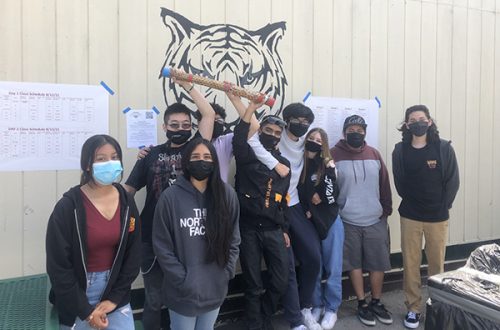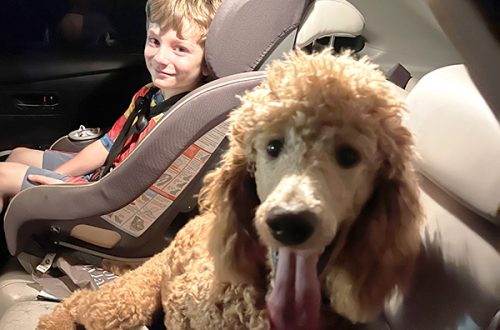
Book Review
Sarah and the Big Wave
By Jeanette Prather
In a pandemic-friendly, COVID-ridden world, it can be hard to fill seats at an in-person event. That wasn’t the case for the authors of Sarah and the Big Wave, the parking lot at Vintage Faith Church, and Sarah Gerhardt – the first woman to surf the revered Mavericks.
“I’m amazed that we sold out of books!” Said Gerhardt about the original ten books that turned into 28 when Gerhardt’s husband, Mike, had to run out and get more. Those sold out as well. “There are so many people. The turnout is great!”
What was the secret sauce in Gerhardt’s family-friendly, free event that drew over 100 people and compelled a supply shortage of her book? Sarah’s story and her subsequent perspective on life
Sarah’s Story
“When I was little, my mom was diagnosed with muscular dystrophy, which is a really debilitating awful disease,” said Gerhardt. “It caused muscle degeneration and she eventually lost her ability to walk, so she would spend about five days in bed every week, and then a couple of days per week my older sister and I would help her get out of bed and walk around.
“My dad had become a merchant marine so he would be gone sailing around the world for a long time,” she continued. “So, it was just my sister and I, then my parents divorced and when my sister was 15, she went to go live with our dad, which was really her living on her own. I was left with my mom when I was ten, and so I cared for her.”
Gerhardt mentioned that there was much struggle and poverty during this time in her life. “We didn’t always have enough food to eat nor simply the basic necessities like clothing and shoes,” she said. “Despite this, my mom was amazing. She stretched every penny and just tried to make things special.”
Additionally, Gerhardt said that, while undiagnosed at the time, she learned later in life that she has ADHD and anxiety, which didn’t help her socialization with her peers. “That, with the stigma around my mom’s condition and what we were going through, aided in why I was sort of an outcast. I struggled with bullying as a kid. It was awful,” said Gerhardt. “Isolation, depression, anxiety are all results of this.”
On the Therapy of Surfing
“I think what drew me to surfing is my make-up,” said Gerhardt. “I have ADHD and still struggle with anxiety, and so it’s a place for me where all of my brain cells get pinged at the same time. I’m comfortable with moving around, where the wave is, where the people are… I’m not bored. It’s the perfect stimulation for me and allows me to come back to land a much calmer person.”
Gerhardt compared the ocean to a mirror. “It’s a mirror of my mind, my body, my soul, my spirit, and it allows me the opportunity for reflection,” she said. “When I’m paddling back maybe I’ll think about my response to a person, or maybe the burdens that I’m carrying and how I can lift them up in prayer.”
If left to her own device, Gerhardt said that she would surf all day. On the topic of surfing as a form of therapy, Gerhardt referenced Blue Minds by Wallace J. Nicols. “There are all these cognitive and emotional benefits that we derive every time we spend time by water,” Nicols told Ben Tracy during a CBS Morning report back in 2014. “It’s chemistry. It’s biology. It’s physiology. It’s deeply personal but it’s also strong science.”
“Using brain imaging, [international scientists and neurologists] have found that proximity to water plugs the brain with feel-good hormones such as dopamine, serotonin and oxytosin,” said Tracy in his report. “Levels of the stress hormone, cortisol, actually drop.”
“I know there is research being done for people with PTSD and trauma, and there is even a program for veterans to surf called Operation Surf,” said Gerhardt. “There is a similar effect with people who have anxiety or ADHD; they can get stuck in this place of high cortisol, and the water – even looking at it – is shown to calm people down. I know for myself personally, that the water is a great therapist.”
How Sarah Landed in Santa Cruz
“In 1989 or 1990 I started surfing in the Central Coast and it wasn’t a fairy tale start by any means,” said Gerhardt. “I had a tiny board and there weren’t surf schools back then. No foam boards or anything. I just went out and got worked repeatedly. It was totally crazy.”
Gerhardt said that despite this, she was drawn to the ocean. “I could leave all my troubles on the shore,” she said. “Instead of running away from who I was, I think I was running towards the person I was becoming.”
After a couple of years on the Central Coast, Gerhardt began surfing Oahu before returning to the States as Mavericks was being discovered as a surfing thrill-seeker’s destination spot. “Mavericks had just been ‘discovered’ and publicized,” said Gerhardt. “Jay Moriarity had just gotten on the cover of Surfer magazine in an incredible, but unfortunate, wipeout. So, my curiosity was peaked about that particular wave because I grew up along Northern California’s coast.”
Simultaneously, Gerhardt’s mom was very sick and the prospect of finishing her degree at Cal Poly was growing thin. Despite this, she said that surfing Mavericks was always in the back of her mind. “Maybe the thought was a distraction, but I was very curious about it and even drove up to where Maverick’s is by myself,” she said. “I then got Richard Schmidt’s number, called him and he was all, ‘Uh, you did what?’”
With a lot of help and support from friends after her mom had passed, Gerhardt was able to get her chemistry degree from Cal Poly. “I decided to go to grad school at UCSC in part for the support they provide to teaching assistants, as well as the physical chemistry program, and of course, the surf,” said Gerhardt. “And it’s close to Maverick’s.”
Being a Female Big-Wave Chaser (and Eventually Tackling Maverick’s)
“I had the experience of surfing big waves with just enough skill to capture my interest to go out again,” said Gerhardt. “At the same time, I was experiencing a lot of pushbacks or cat-calls from guys who would say, ‘Oh you shouldn’t go out, it’s too big for you,’ or ‘You don’t belong here.’
“What I found is if I paddled out, most of those people stayed on the shore and so I could leave them behind. It was a very happy place for me,” she continued. “I’m very, very curious about what’s out there and I wanted to know if I could do it, if I could catch those waves. Even if I didn’t get any waves that day, I wanted to see what it was like out there.”
Gerhardt took nine months off school before attending UCSC in 1998, where she moved back to Oahu and married long-time surfing friend and well-known big wave surfer, Mike Gerhardt. “He was really good friends with Moriarity, who surfed big waves as well, and we already had been training with each other for years including the physical and mental preparation it takes to surf big waves,” said Gerhardt. “So, I hadn’t shown up to Maverick’s untrained.”
After three seasons of surfing big waves in Oahu, Gerhardt said it felt natural that the next step for her was to surf Mavericks. Met with yet another setback of not being prepared to attend grad school because she had left the world of academia for nine months, Gerhardt said that she really struggled upon her embarkment in UCSC’s graduate program.
“I poured every waking moment into learning and trying to get caught up to speed so I could just be prepared to do research and everything I’d need to do for school,” said Gerhardt. “During that time my fitness went down, and I wasn’t focusing on surfing, although I did surf.”
Inevitably, when that first Mavericks swell came, Moriarity called the Gerhardts to surf the big wave the next day. “I was like, ‘Oh no.’ I wasn’t ready,” said Gerhardt. “I didn’t have a board and so I had to borrow one to paddle out. I just went out there and got so worked on just the paddle-out.”
Not only is the water at Mavericks incredibly cold, according to Gerhardt, but the waves break everywhere due to multiple reefs under the water. “I was just not there mentally or physically, and I realized that on the paddle-out. It was a bit heart-breaking but at that time my priorities had shifted,” she said. “I went out there and got my mind blown, then I sat in the channel and watched my husband and Jay getting great waves. I was utterly blown away at how powerful it was.”
The videos that Gerhardt’s crew watched to analyze and prepare for Mavericks didn’t do the wave justice, explained Gerhardt. “They don’t show that upon every take-off, there are these little bumps that turns up the face and you get air. Literally, every wave pitches, and then the way it stands up again inside… it just blew my mind.”
Disheartened, Gerhardt wasn’t sure if she would be able to ride waves out there. But determined not to give up, she went back out a few months later on her husband’s board, met a lot of inspiring surfers and tried again. “One of the surfers out there that day was Frosty. He went home and, on the way, stopped by Bob Pearson’s and said, ‘I just saw the first woman who’s going to surf Mavericks.’”
In a timely series of events, Moriarity, who surfed for Pearson at the time, told Gerhardt to get a board made for her, so she did. When she paddled out at Mavericks with her new board in February 1999, Gerhardt finally caught the wave. “It was mentally and physically helpful to be on the right equipment, and I got it,” she said. “The ride was clean and neutral.
“I’ve gotten so worked there, but I’ve also had the most incredible experiences that nothing in my life comes close to, and have met the most amazing people who I admire, love and respect.”
Spirituality, Hope and Routine
Gerhardt’s mother was very spiritual, and according to Gerhardt, despite not having a fully functional physical body, she still had a lot of hope and compassion. “She wanted to help people in their lives, and she had a very well-developed spiritual component in her own life,” said Gerhardt. “As a mom, she worried about me, my sister and about providing for us. She knew that she couldn’t do what able-bodied people could do, so she spent hours and hours every day in prayer.”
Every summer, Gerhardt’s mother would take her and her sister camping at Memorial Park in the redwoods. “My mom was best friends with one of the naturalists and she allowed me to be a part of her docent and junior rangers team, which was a life-changing experience for me,” she said.
Those early spiritual experiences helped shape Gerhardt’s current daily routines and thoughts on hope. “I get up really early and have a routine of reading, writing, journaling, praying, meditating and doing core exercises” she said. “For me, it’s important to find that quiet place and sometimes that means that I get up at 4 or 4:30 am if I have to. If I can in the morning, I will go surf early.”
A firm believer that things can always get better, Gerhardt attributes her level and sense of hope to being journey-oriented over destination-oriented. “As a community, we feel discouraged if we don’t meet our destination, then all of those negative thoughts begin to happen,” she said. “I think having the shift away from destination-focus to journey-focus, and then realizing that the detours are actually really important, is necessary. It’s within the failures, just like in science, that we make new discoveries. It’s within the detours that we make new friends and become more resilient.”
Gerhardt, who clearly recognizes the ups and downs of life, suggests that anyone going through a difficult time remembers that nothing in life is fixed or stays the same. “Things will change, and things will get better; circumstances will change, and you will change,” she said.
A self-proclaimed introvert, Gerhardt strongly discourages withdrawing and isolating oneself as a potential solution for weathering the hard times. “Especially when I couldn’t put my best face forward, I’d want to withdraw and not be out,” she said. “But I didn’t get to where I am today without the help from other people.
“Joy is not something that is based on circumstances or found externally,” Gerhardt continued. “It is found internally and it’s available to everybody. It requires that we slow down, become quiet and allow ourselves to contemplate.”


You May Also Like

Independent Schools Review
January 1, 2022
Stress Busters
January 1, 2022

